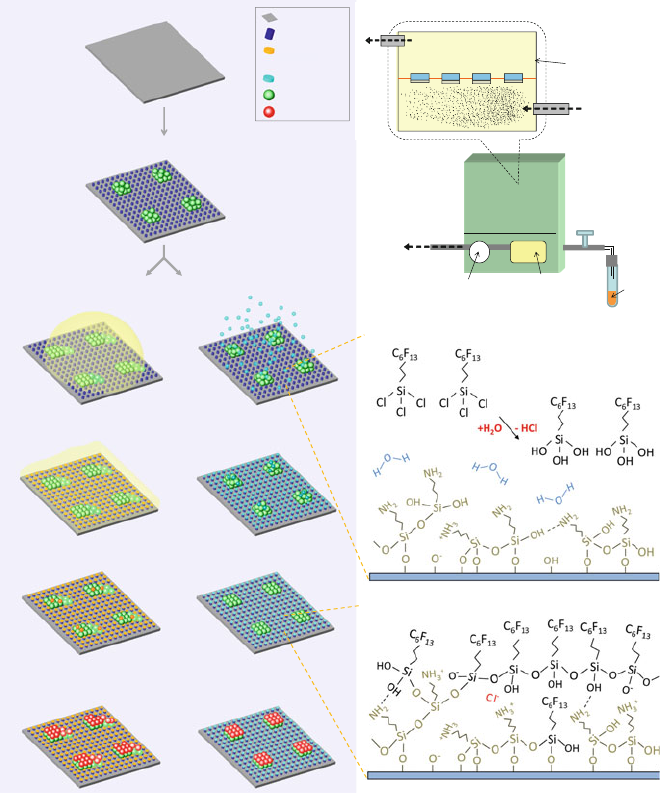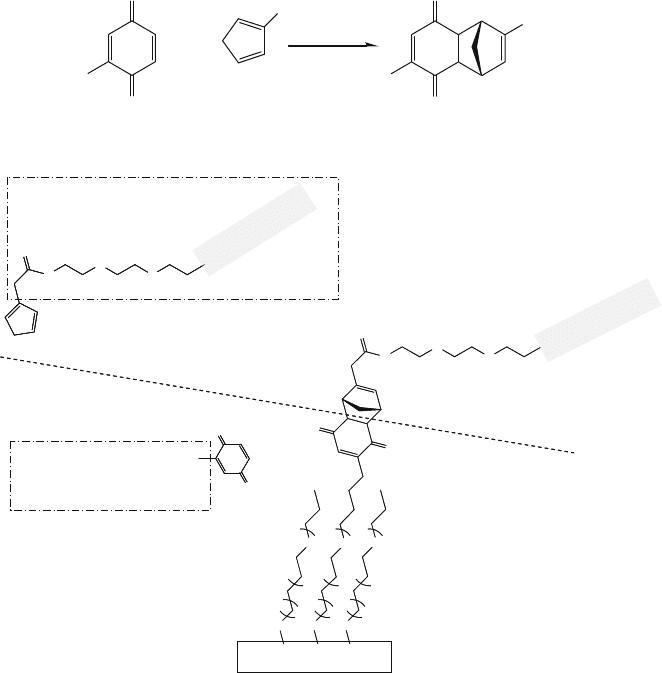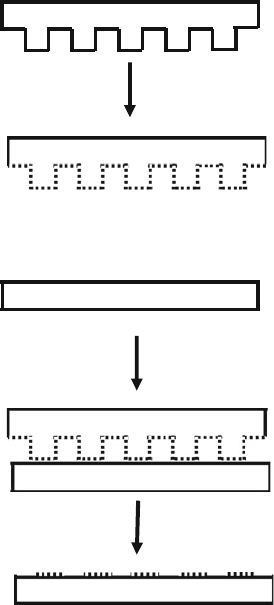Ghodssi R., Lin P., MEMS Materials and Processes Handbook
Подождите немного. Документ загружается.

964 P. Lin e t al.
Then a cross-linker was used to immobilize the bioactive proteins on a pre-adsorbed
BSA layer, with the chemistry as shown in Example 14. The employed strategy
(Fig. 13.27b) results in less blocking of protein A on the surface, and higher reac-
tivity with the antibody (Y). This new method significantly improves the ELISA
detection efficiency using the same PDMS microfluidic system.
13.5.4.2 Case Study 2: Effective Enhancement of Fluorescence Detection
Efficiency Using Alternative Blocking Process in Protein Microarray
Assays
Aminosilanized silica substrates are used to prepare protein microarrays because of
their strong binding affinity for proteins. In a typical microarray preparation proce-
dure, after the probe proteins are spotted on an aminosilanized silica substrate, the
background surface of the spotted silica substrate needs to be blocked to prevent
nonspecific adsorption of target proteins. Conventionally, protein-based blocking
solutions, such as albumin solutions (e.g. BSA solution), non-fat milk solutions,
casein solutions or serum solutions are used. Although aminosilanized silica sur-
faces can be passivated by protein-based blocking solutions, a wet blocking process
often causes smearing of individual protein spots and cross-contamination among
probe spots (Fig. 13.28, steps c1 to f1). To eliminate the smearing and cross-
contamination issues caused by conventional blocking processes using protein-
based blocking solutions, Hsieh et al. employed a vapor-phase blocking process
[93]. This method employs a highly fluorinated organosilane, FOTS (see No. 10
in Fig. 13.7), as the blocking agent to passivate the background surfaces of pro-
tein arrays prepared on aminosilanized glass slides (Fig. 13.28,stepc2tof2).As
shown in Fig. 13.28 h and i, upon hydrolysis, FOTS can be made reactive, and
bonds to the APTS ( also called APTES, in Fig. 13.7) surface. During the vapor-
phase FOTS blocking treatment, the exterior protein molecules extensively exposed
to the FOTS vapor can serve as sacrificial materials to protect the interior pro-
tein molecules. Moreover, these loosely bound exterior protein molecules can be
subsequently washed off from the spotted areas without causing undesired contami-
nation on the background surface that has been passivated by the vapor-phase FOTS
treatment.
Compared to several conventional blocking processes that use protein-based
solutions, it was demonstrated that the vapor-phase blocking process could signif-
icantly reduce the smearing of protein spots and effectively enhance fluorescence
detection efficiency by up to ~64 times [93].
13.5.4.3 Case Study 3: Control of Specific Reaction Kinetics Involving
Bifunctional Cross-Linkers
AFM probes can be made into sensitive, chemically selective biosensors by attach-
ing ligand molecules to the tips of the probes [94]. Many model systems that
utilize ligands on AFM probes and complementary receptors on substrates have

13 Surface Treatment and Planarization 965
(a) cleaned slide
(b) array-spotting on an APTS-modified slide
(c1) wet blocking
(HS, MILK, or BSA)
(d1) completion of wet blocking
(e1) PBST washing
(f1) completion of conjugation
& final washing
(c2) vp-FOTS blocking
(d2) completion of
blocking
vp-FOTS
(e2) PBST washing
Conventional
Wet Blocking
Vapor-Phase
Blocking
Slide
APTS
Protein-Based
Blocking Agent
FOTS
2nd Ab (Cy5)
1st Ab (Cy3)
(f2) completion of conjugation
& final washing
APTS
treatment
(g)
(h)
(i)
Pressure meter
Temperature
controller
Valve
To t h e
mechanical
pump
Slides
(upside down)
Plastic box
FOTS vapor
FOTS
liquid
Fig. 13.28 Background blocking of protein arrays by a conventional protein-based wet blocking
process vs. a vapor-phase blocking process using a highly fluorinated organosilane, 1H,1H,2H,2H-
perfluorooctyltrichlorosilane (FOTS) [94]. Reprinted with permission. Copyright 2009 American
Chemical Society
been developed to study the dynamics of molecular interactions. The tips of AFM
probes are made of polysilicon or silicon nitride. These surfaces are typically cov-
ered with a natural silicon oxide layer, and contain many r eactive -SiOH groups.
As described in Section 13.5.2.3, to start a multi-step modification on such type
of surfaces, organosilanes with amine (such as APTES) or other functional groups
966 P. Lin e t al.
are r equired. After surface silanization of the AFM tip, a bifunctional cross-linker is
needed to bond the ligand (or antibody) to the AFM tip. The cross-linkers must have
a very flexible chain, and PEG (polyethylene glycol) is typically used to provide
sufficient chain flexibility. As several surface modification schemes with different
combinations of organosilanes and PEG-based bifunctional cross-linkers are pos-
sible, the reaction profiles and kinetics can differ from one scheme to another. To
address how to handle these issues, five different schemes for AFM tip coating are
provided as examples, and a discussion follows.
First, the linkage to the antibody is through the disulfide exchange reaction.
Ebner et al. has been working on the synthesis and application of PEG-based
heterobifunctional cross-linkers for the immobilization of antibodies onto AFM
tips [95]. In their earlier study, PDP-PEG-NHS was used as the cross-linker to
react with aminosilanized AFM tips [ PDP is 3-(2-pyridyl)-dithiopropionyl, which
contains a disulfide bond, i.e. PDP can undergo the exchange reaction described
in reaction (13.10) with a thiol group; NHS is N-hydroxysuccinimide group, see
reaction (13.6)]. Because there are no free thiol groups on antibodies, the thiol
groups need to be introduced to the antibody first. The thiolated antibody needs
to be purified before usage because the residual reagents and byproducts from
the thiolation process can also react with the PDP group on the cross-linkers.
To avoid the extra purifying process, another strategy is to treat the aminosi-
lanized AFM tips with NHS-PEG-NHS to immobilize the antibodies. Compared
to PDP-PEG-NHS, NHS-PEG-NHS is preferred because there is no need to add
thiol groups to the antibody. However, the NHS-PEG-NHS has two amine-reactive
NHS groups, and it can lose them both if they each react with the surface-bound
amino groups. To prevent this, Ratto et al. developed another strategy, in which
a mixture of APTES (see Fig. 13.7) and MTES [CH
3
-Si-(OC
2
H
5
)
3
] was used
in the ratio of 1:250 to prepare an aminosilanized surface diluted by the methyl
groups of MTES [96]. This would reduce the reaction kinetics of the amino groups
on APTES towards the NHS group of the cross-linker, NHS-PEG-NHS. Using
this strategy, one NHS group in the cross-linker could r emain to react with the
antibody.
Alternatively, the AFM tip can be treated with 3-mercaptopropyl-
trimethoxysilane to produce reactive thiol groups, and a maleimide-PEG-NHS
cross-linker can be used to react with the AFM tip via a reaction between
the maleimide and thiol groups. Although a thiol functional group reacts with
maleimide relatively quickly, it still can react with NHS to some extent, though
less favorably. Thus this technique cannot completely prevent the cross-linker from
forming a loop on the AFM tip. Another strategy that was recently developed by
Ebner employed NHS-PEG-CHO as a cross-linker to react with aminosilanized
AFM tips [95]. Although both NHS and CHO can react with the amino group, the
kinetics of amine with NHS overwhelms the kinetics of amine with CHO; as such,
NHS-PEG-CHO preferentially reacts with the surface-bound amino group via the
NHS group. Following the treatment of the AFM tips with NHS-PEG-CHO, the
free CHO group can be exploited to react with the amino group of the antibody for
the preparation of biofunctional AFM tips.

13 Surface Treatment and Planarization 967
13.5.4.4 Case Study 4: Surface Modification Using Elaborately Derivatized
Functional Groups
To exploit alternative chemical reactions for surface modification in BioMEMS,
organic synthesis can be performed to prepare chemical species derivatized with
special functional groups for desired chemical reactions to occur. For example,
Houseman et al. exploited the Diels-Alder reaction (13.15) to perform mediated con-
jugation between the cyclopentadiene group derivatized on a peptide analogue and
the benzoquinone group immobilized on a gold surface (Fig. 13.29)[97]. Although
substantial synthetic work is required to synthesize a cyclopentadiene-derivatized
peptide analogue and a benzoquinone-derivatized thiol, this study shows that chem-
ical conjugation via the Diels-Alder reaction is highly efficient and selective for the
O
O
O
O
R'
R'
+
R
R
(13.15)
Au
Peptide Analogue
R
O
N
H
O
O
Peptide Analogue
AuAu
-
S
-
(CH
2
)
10
-
(OC
2
H
4
)
7
-
C
2
H
4
O
O
R’
S
O
S
O
S
O
OH
OH
O
O
O
N
H
O
O
7
7
7
5
7
5
Fig. 13.29 Mediated conjugation of a peptide analogue to a Au-based substrate via Diels-Alder
reaction, as demonstrated by Houseman et al. [97]

968 P. Lin e t al.
preparation of peptide chips. As mentioned in Case study 3, the cross-linking reac-
tions are sometimes not very specific and can cause different side reactions. If a
very specific and efficient reaction is required, preparation of certain compounds or
reagents with desired functional groups by elaborate synthesis may be necessary.
13.5.4.5 Case Study 5: Surface Patterning by Microcontact Printing
Microcontact printing is a surface patterning technique that can be conveniently
employed for many applications [98–105]. The basic working principle of micro-
contact printing is illustrated in Fig. 13.30. To perform surface modification by
microcontact printing, a patterned elastomer stamp (usually a PDMS stamp) must
be fabricated. Then an “ink” solution containing a chemical (or a mixture of chem-
icals) that can react with the target substrate surface (e.g. organosilanes for silica
surfaces, thiols for noble metal surfaces) is applied to the patterned stamp surface.
Depending on the nature of the “ink” solution, (e.g. viscosity, reactivity, stability
etc.), some precautions must be considered during the preparation, handling and/or
Target substrate
PDMS stamp
PDMS stamp “treated”
with the “ink” solution
Microcontact printing
Target substrate surface
patterned by microcontact printing
+
Fig. 13.30 Schematic illustration of microcontact printing
13 Surface Treatment and Planarization 969
application of the “ink” solution (e.g. concentration of the “ink” solution, extent to
which the solvent of the “ink” solution should evaporate after the “ink” has been
applied to the patterned stamp surface, etc). Ideally, only a thin physically adsorbed
layer of the s urface-reactive chemical on the patterned stamp surface is desired after
the elastomer stamp is “treated” with the “ink” solution. Then the stamp is brought
into contact with the target substrate surface. As shown in Fig. 13.30, the surface-
reactive chemical reacts with the target substrate surface in the areas that contact the
patterned stamp surface. After the stamp is removed from the target substrate sur-
face, a geometrically and chemically defined pattern can be obtained on the target
substrate surface for further use.
Because of its ease and convenience, microcontact printing is widely used for the
preparation of patterned bioactive surfaces [106]. For example, Chen et al. prepared
gold surfaces with patterned bioactive proteins (fibronectin, vitronection, collagen
etc.) to study the growth and apoptosis of bovine capillary endothelial cells [107].
The gold surface was first patterned with hexadecanethiol by microcontact printing.
The patterned gold surface was then treated with a tri(ethylene glycol)-terminated
hexadecanethiol solution to passivate the rest of the unpatterned gold surface.
When the above patterned/passivated gold surface was immersed in a protein solu-
tion, preferential adsorption of the protein occurred on the area with hydrophobic
hexadecyl SAM coating. Finally, cell cultures grown on the gold surfaces with var-
ious patterned bioactive proteins were investigated and compared. From this study,
Chen et al. found that it was the extent of cell spreading, not the area of adhesive
contact, that controlled the life and death of bovine capillary endothelial cells.
13.6 Surface Coating for Optical Applications
MEMS devices have been applied to optical sensing applications and light-
wave communications including optical switches, waveguides, tunable filters, and
reconfigurable wavelength add and drop multiplexers. Components in these MEMS
devices interact, receive, and transport light. As light interacts with MEMS devices,
three optical functions are relevant to performance: reflection, transmission, and
absorption. The surfaces on the MEMS devices have strong effects on these optical
functions.
Many optical materials can be processed in MEMS fabrication, including non-
crystalline materials (such as glasses and metals), crystalline materials (such as sil-
icon, quartz, and germanium wafers), and polymers (plastics, photoresist, and elas-
tomers). The fabrication techniques used to obtain the desired optical properties –
such as physical vapor deposition, chemical vapor deposition, sol-gel, spin coatings,
self assembly, phase separation, and imprinting – are discussed in the other chapters
of this book.
This section begins with theory and design concepts related to the optical
phenomena of surface films, including refraction, dispersion, absorption, internal/

970 P. Lin e t al.
external reflection, polarization by reflection, and antireflection. The material prop-
erties and fabrication processes of these coatings and structures are discussed in
the second part of this section, along with their corresponding advantages and
challenges. Several useful case studies related to antireflection, absorption, and
refraction of designated light waves will be discussed as examples of the design and
fabrication of optical MEMS devices. Lastly, surface roughness and control will be
summarized.
13.6.1 Fundamentals of Optical Phenomena on Surface Coatings
The performance of optical MEMS devices usually relies on functional optical prop-
erties such as antireflection, high absorption, refraction, and polarization of device
surfaces. The desired properties are usually achieved by applying special coatings or
material structures to the surface. Most optical property transformations through sur-
face coatings and structures are based on the scattering or interference of light waves
at the interface [108, 109]. The interface is very sensitive to film thickness relative
to the wavelength of the incident light, which can range from tens of nanometers
to several microns. As a result, surface planarization properties [109] have strong
effects on the phenomena occurring at the incident interfaces. Since the design and
selection of coatings and structures are typically the first things to consider, we will
start with optical theory and design concepts in this section.
13.6.1.1 Index Variation of Materials Versus Wavelength [108]
Dielectric Materials
When light transmits in the medium of bulk matter, for example in a homogeneous,
isotropic dielectric material, the phase speed of the light in the medium can be
expressed by
v =
1
√
εμ
(13.16)
where ε is the permittivity and μ is the permeability of the medium. As a result, the
ratio of the speed of an electromagnetic wave in a vacuum to its speed in matter is
defined as the absolute index of refraction, n:
n ≡
c
v
=
εμ
ε
0
μ
0
(13.17)
where c is the light speed, ε
0
is the permittivity, and μ
0
is the permeability in free
space.
The index n can also be expressed in t erms of the relative permittivity and relative
permeability of the medium:

13 Surface Treatment and Planarization 971
n =
K
E
K
M
≈
K
E
(13.18)
where K
E
= ε/ε
0
is the dielectric constant or relative permittivity, and K
M
= μ/μ
0
is the relative permeability. Since K
M
does not usually deviate much in the visible
regions of the spectrum, it can be neglected.
This relation is only valid for a few simple gases such as air, helium, and hydro-
gen. The approximate refractive indices of some commonly used materials are listed
in Table 13.3, and in other sections (Tables 13.4, 13.5, 13.6, and 13.7). However, the
indices of dielectric materials are often frequency-dependent. This is called “dis-
persion”, and can be expressed by the dispersion equation f or a dielectric material:
n
2
(ω) = 1 +
Nq
2
e
ε
0
m
e
1
ω
2
0
− ω
2
(13.19)
where q
e
is the electron charge, m
e
is the electron mass, N is the number of con-
tributing electrons per unit volume, and ω
0
is the resonance frequency. The index n
increases as ω approaches ω
0
from below, but drops to less than 1 when ω is larger
than ω
0
. The index of an optical material varies with wavelength (index dispersion),
as indicated in Fig. 13.31. The region with a large index jump corresponds to the
absorption bands of the material. After the jump, the index starts to decrease as
wavelength increases, until the wavelength reaches the next absorption band. Jumps
may be located in different regions of the spectrum, for example one in the infrared
(ω
i
) region and the other in the ultraviolet (ω
u
) region. The targeted visible spectra
lie between these regions.
Metals
When light interacts with bulk metal, the conduction electrons undergo oscillation
and collisions with the lattice, and thereby generate absorption. The electrical field
Table 13.3 Approximate indices of refraction of various substances [108]
Air 1.00029 Light flint glass 1.58
Ice 1.31 Polystyrene 1.59
Water 1.333 Carbon disulfide (CS
2
) 1.628
Ethyl alcohol (C
2
H
5
OH) 1.36 Dense flint glass 1.66
Fused silica (SiO
2
) 1.4584 Lanthanum flint glass 1.80
Carbon tetrachloride (CCl
4
)1.46 Zircon(ZrO
2
SiO
2
) 1.923
Turpentine 1.472 Fabulite (SrTiO
3
) 2.409
Benzene (C
6
H
6
) 1.501 Diamond (C) 2.417
Plexiglass 1.51 Rutile (TiO
2
) 2.907
Crown glass 1.52 Gallium phosphide 3.50
Sodium chloride (NaCl) 1.544 Silicon nitride (Si
3
N
4
)2.04
Reprinted with permission. Copyright 2002 Addison Wesley

972 P. Lin e t al.
Table 13.4 Properties of antireflection coating materials [109, 110]
Material
Refractive index at
λ = 546 nm
Evaporation
temperature (
◦
C) Comments
Aluminum oxide (Al
2
O
3
) 1.66 2045 E-beam evaporation with substrate at 200
◦
C, hard and chemical
resistant film
Cadmium sulphide (CdS) 2.42 800 E-beam evaporation in high vacuum, requires care
Cadmium telluride (CdTe) 2.69 E-beam evaporation
Ceric oxide (CeO
2
) 1.95 1600 Thermal evaporation, soft film
Cerous fluoride (CeF
3
) 1.63 1342 E-beam evaporation with substrate at 200
◦
C
Hafnium oxide (HfO
2
)2.05
Cryolite (Sodium aluminum
fluoride, Na
3
AlF
6
)
1.22 1000 Thermal evaporation, soft film
Lanthanum fluoride (LaF
3
) 1.55 1490 Thermal evaporation
Lead fluoride (PbF
2
) 1.75 855 Thermal evaporation, soft film
Lithium fluoride (LiF) 1.303 870 Thermal evaporation in high vacuum, soft transparent film
Magnesium fluoride (MgF
2
) 1.38 1266 Thermal evaporation in high vacuum
Magnesium oxide (MgO) 1.68 2800 E-beam evaporation, hard film
Neodymium fluoride (NdF
3
) 1.55 1410 Thermal evaporation, very hard and t ransparent film
Neodymium oxide (Nd
2
O
3
) 1.79 1900 Thermal evaporation, very hard and transparent film
Silicon monoxide (SiO) 1.49–1.80 1250 Depends on the rate of deposition, thermal evaporation at O
2
environment, hard film
Silicon-silica mix (Si-SiO
2
) 1.49 Thermal evaporation, hard and transparent film
Sodium fluoride (NaF) 1.29 988 Thermal evaporation, soft and transparent film, easily to be attacked
by moisture

13 Surface Treatment and Planarization 973
Table 13.4 (continued)
Material
Refractive index at
λ = 546 nm
Evaporation
temperature (
◦
C) Comments
Thorium oxide (ThO
2
) 1.86 3050 E-beam evaporation with substrate at 200
◦
C
Thorium oxyfluoride (ThOF
2
) 1.50 1100 Thermal evaporation, good adhesion to substrate
Titanium monoxide (TiO) 2.08–2.32 1750 Depends on the rate of deposition, slow thermal evaporation at O
2
environment, hard and transparent film
Yttrium oxide (Y
2
O
3
) 1.79 2410 E-beam evaporation, very hard film
Zinc selenide (ZnSe) 2.57 900 Thermal evaporation, soft and transparent film
Zinc sulfide (ZnS) 2.35 1000 Thermal evaporation, soft and transparent film
Zirconium oxide (ZrO
2
) 2.05 2714 E-beam evaporation with substrate at 200
◦
C
Germanium (Ge) 4.0
a
E-beam evaporation
Silicon 3.50
a
E-beam evaporation
a
not transparent in visible spectrum
Reprinted with permission. Copyright 2008 McGraw-Hill and Copyright 1970 Institute of Physics
